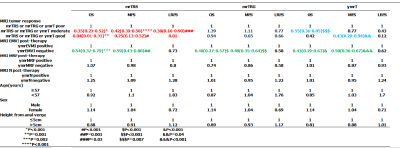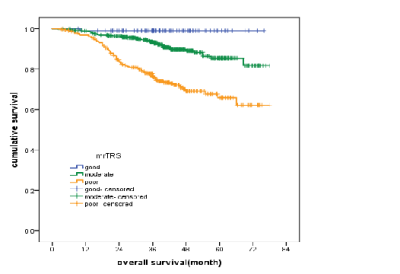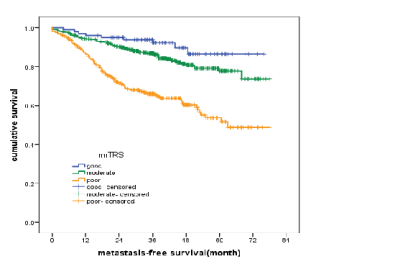4761
The value of novel magnetic resonance imaging tumor response score for locally advanced rectal cancer: a prospective and multicenter study1Beijing cancer hospital, Beijing, China
Synopsis
Our study enrolled four possible predictive imaging parameters of the pTRG and establised the magnetic resonance imaging tumor response score for the theraputic evaluation and prognosis prediction of LARC. The objective and semi-quantitative mrTRS was established for the first time in this study, which is an independent factor of overall survival, distant metastasis and local recurrence.
The value of novel magnetic resonance imaging tumor response score for locally advanced rectal cancer: a prospective and multicenter study
Purpose:To establish an objective and semi-quantitative imaging scoring criteria for response assessment in locally advanced rectal cancer(LARC), and to explore the value of the new method by studying its correlation with prognosis.
Methods:
Based on the retrospective study in a single center, we analyzed the possible predictive indicators of pathological tumor regression grade (pTRG)[1-2] and established the magnetic resonance imaging tumor response score (mrTRS) . Through the prospective and multicenter study involving 878 LARC patients, we evaluated imaging features including T staging, N staging, extramural venous invasion (EMVI), mesorectal fascia(MRF) status, mrTRS, magnetic resonance imaging tumor regression grade (mrTRG)[3], and pathological features including pTRG, pT staging and pN staging. Kaplan-Meier method with log-rank estimate was conducted to compare survival curves. Multivariate cox regression was performed to obtain the adjusted hazard ratios (HR) of MRI and pathology tumor regression variables.
Results:
Multivariate analysis showed that OS, MFS and LRFS were significantly different among the three groups judged by mrTRS. There was no apparent difference in OS, MFS and LRFS among the groups differentiated by mrTRG. OS and MFS were divergent between the good and poor responders according to pTRG, there was no difference in OS and MFS between the moderate and poor groups.
Conclusion:
The new mrTRS is an independent prognostic factor for rectal cancer. It is also conducive to the evaluation of neoadjuvant therapy, the selection of next treatment options and the assessment of prognostic risk.
Acknowledgements
I would like to take this chance to express my sincere gratitude to my supervisor, Yingshi Sun, who is the director of the Radiology Department of the Beijing cancer hospital , for his kindly assistance and valuable suggestions during the process of the study.References
[1]Mandard A M, Dalibard F, Mandard J C, et al. Pathologic assessment of tumor regression after preoperative chemoradiotherapy of esophageal carcinoma. Clinicopathologic correlations[J]. Cancer, 1994, 73(11): 2680-2686.
[2]Dworak O, Keilholz L, Hoffmann A. Pathological features of rectal cancer after preoperative radiochemotherapy[J]. International journal of colorectal disease, 1997, 12(1): 19-23.
[3]Patel U B, Taylor F, Blomqvist L, et al. Magnetic resonance imaging–detected tumor response for locally advanced rectal cancer predicts survival outcomes: MERCURY experience[J]. Journal of Clinical Oncology, 2011, 29(28): 3753-3760.
Figures



